Steve Blank
AI and the DoD
The Department of Defense has thought that AI is such a foundational set of technologies that they started a dedicated organization -- the JAIC -- to enable and implement artificial intelligence across the Department. They provide the infrastructure, tools, and technical expertise for DoD users to successfully build and deploy their AI-accelerated projects.
Some specific defense-related AI applications are listed later in this document.
We’re in the Middle of a Revolution
Imagine it’s 1950, and you’re a visitor who traveled back in time from today. Your job is to explain the impact computers will have on business, defense and society to people who are using manual calculators and slide rules. You succeed in convincing one company and a government to adopt computers and learn to code much faster than their competitors /adversaries. And they figure out how they could digitally enable their business – supply chain, customer interactions, etc. Think about the competitive edge they’d have by today in business or as a nation. They’d steamroll everyone.
That’s where we are today with Artificial Intelligence and Machine Learning. These technologies will transform businesses and government agencies. Today, 100s of billions of dollars in private capital have been invested in 1,000s of AI startups. The U.S. Department of Defense has created a dedicated organization to ensure its deployment.
But What Is It?
Compared to the classic computing we’ve had for the last 75 years, AI has led to new types of applications, e.g. facial recognition; new types of algorithms, e.g. machine learning; new types of computer architectures, e.g. neural nets; new hardware, e.g. GPUs; new types of software developers, e.g. data scientists; all under the overarching theme of artificial intelligence. The sum of these feels like buzzword bingo. But they herald a sea change in what computers are capable of doing, how they do it, and what hardware and software is needed to do it.
This brief will attempt to describe all of it.
New Words to Define Old Things
One of the reasons the world of AI/ML is confusing is that it’s created its own language and vocabulary. It uses new words to define programming steps, job descriptions, development tools, etc. But once you understand how the new world maps onto the classic computing world, it starts to make sense. So first a short list of some key definitions.
Artificial Intelligence (AI) - a catchall term used to describe “Intelligent machines” which can solve problems, make/suggest decisions and perform tasks that have traditionally required humans to do. AI is not a single thing, but a constellation of different technologies.
Machine Learning (ML) - a subfield of artificial intelligence. Humans combine data with algorithms (see here for a list) to train a model using that data. This trained model can then make predications on new data (is this picture a cat, a dog or a person?) or decision-making processes (like understanding text and images) without being explicitly programmed to do so.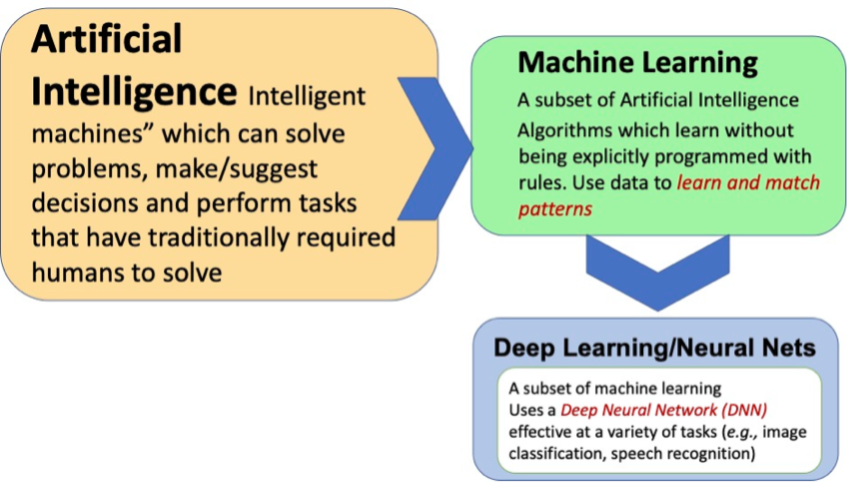

Machine learning algorithms - computer programs that adjust themselves to perform better as they are exposed to more data.
The “learning” part of machine learning means these programs change how they process data over time. In other words, a machine-learning algorithm can adjust its own settings, given feedback on its previous performance in making predictions about a collection of data (images, text, etc.).
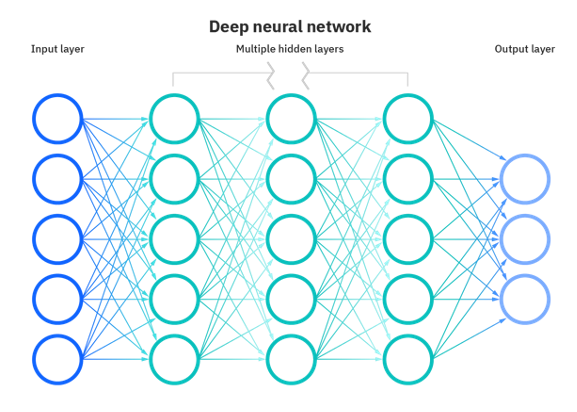
Deep Learning/Neural Nets – a subfield of machine learning. Neural networks make up the backbone of deep learning. (The “deep” in deep learning refers to the depth of layers in a neural network.) Neural nets are effective at a variety of tasks (e.g., image classification, speech recognition). A deep learning neural net algorithm is given massive volumes of data, and a task to perform - such as classification. The resulting model is capable of solving complex tasks such as recognizing objects within an image and translating speech in real time. In reality, the neural net is a logical concept that gets mapped onto a physical set of specialized processors. See here.)
Data Science – a new field of computer science. Broadly it encompasses data systems and processes aimed at maintaining data sets and deriving meaning out of them. In the context of AI, it’s the practice of people who are doing machine learning.
Data Scientists - responsible for extracting insights that help businesses make decisions. They explore and analyze data using machine learning platforms to create models about customers, processes, risks, or whatever they’re trying to predict.
What’s Different? Why is Machine Learning Possible Now?
To understand why AI/Machine Learning can do these things, let’s compare them to computers before AI came on the scene. (Warning – simplified examples below.)
Classic Computers
For the last 75 years computers (we’ll call these classic computers) have both shrunk to pocket size (iPhones) and grown to the size of warehouses (cloud data centers), yet they all continued to operate essentially the same way.
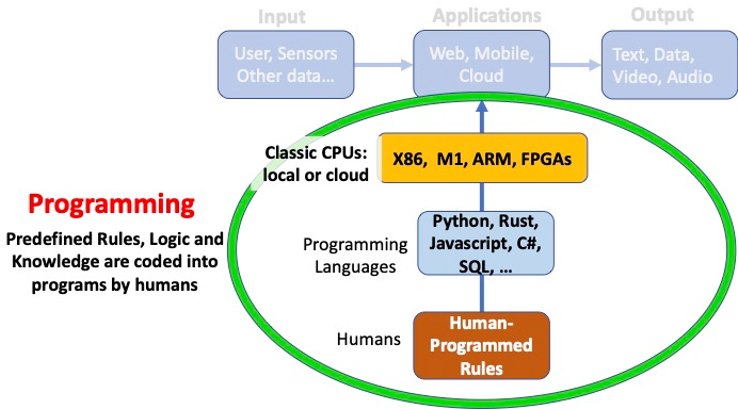
Classic Computers - Programming
Classic computers are designed to do anything a human explicitly tells them to do. People (programmers) write software code (programming) to develop applications, thinking a priori about all the rules, logic and knowledge that need to be built in to an application so that it can deliver a specific result. These rules are explicitly coded into a program using a software language (Python, JavaScript, C#, Rust, …).
Classic Computers - Compiling
The code is then compiled using software to translate the programmer’s source code into a version that can be run on a target computer/browser/phone. For most of today’s programs, the computer used to develop and compile the code does not have to be that much faster than the one that will run it.
Classic Computers - Running/Executing Programs
Once a program is coded and compiled, it can be deployed and run (executed) on a desktop computer, phone, in a browser window, a data center cluster, in special hardware, etc. Programs/applications can be games, social media, office applications, missile guidance systems, bitcoin mining, or even operating systems e.g. Linux, Windows, IOS. These programs run on the same type of classic computer architectures they were programmed in.
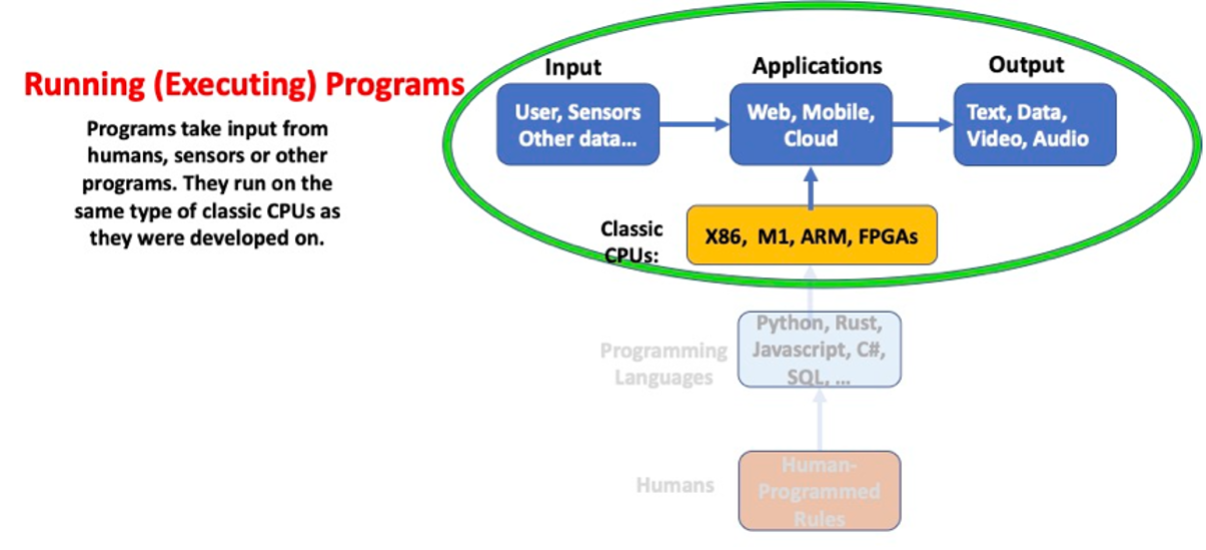
Classic Computers – Software Updates, New Features

For programs written for classic computers, software developers receive bug reports, monitor for security breaches, and send out regular software updates that fix bugs, increase performance and at times add new features.
Classic Computers- Hardware
The CPUs (Central Processing Units) that write and run these Classic Computer applications all have the same basic design (architecture). The CPUs are designed to handle a wide range of tasks quickly in a serial fashion. These CPUs range from Intel X86 chips, and the ARM cores on Apple M1 SoC, to the z15 in IBM mainframes.
Machine Learning
In contrast to programming on classic computing with fixed rules, machine learning is just like it sounds – we can train/teach a computer to “learn by example” by feeding it lots and lots of examples. (For images a rule of thumb is that a machine learning algorithm needs at least 5,000 labeled examples of each category in order to produce an AI model with decent performance.) Once it is trained, the computer runs on its own and can make predictions and/or complex decisions.
Just as traditional programming has three steps - first coding a program, next compiling it and then running it - machine learning also has three steps: training (teaching), pruning and inference (predicting by itself.)
Machine Learning - Training
Unlike programing classic computers with explicit rules, training is the process of “teaching” a computer to perform a task e.g. recognize faces, signals, understand text, etc. (Now you know why you're asked to click on images of traffic lights, cross walks, stop signs, and buses or type the text of scanned image in ReCaptcha.) Humans provide massive volumes of “training data” (the more data, the better the model’s performance) and select the appropriate algorithm to find the best optimized outcome.
(See the detailed “machine learning pipeline” later in this section for the gory details.)
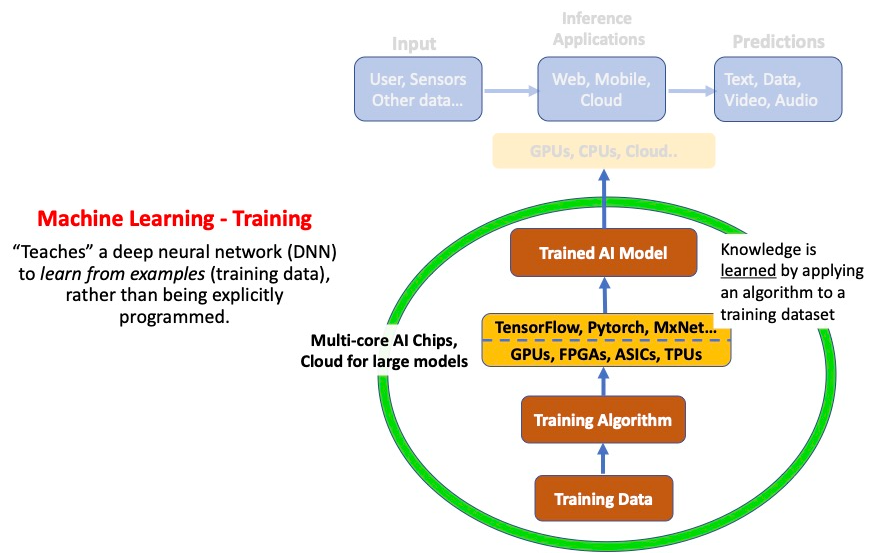
By running an algorithm selected by a data scientist on a set of training data, the Machine Learning system generates the rules embedded in a trained model. The system learns from examples (training data), rather than being explicitly programmed. (See the “Types of Machine Learning” section for more detail.) This self-correction is pretty cool. An input to a neural net results in a guess about what that input is. The neural net then takes its guess and compares it to a ground-truth about the data, effectively asking an expert “Did I get this right?” The difference between the network’s guess and the ground truth is its error. The network measures that error, and walks the error back over its model, adjusting weights to the extent that they contributed to the error.)
Just to make the point again: The algorithms combined with the training data - not external human computer programmers - create the rules that the AI uses. The resulting model is capable of solving complex tasks such as recognizing objects it’s never seen before, translating text or speech, or controlling a drone swarm.
(Instead of building a model from scratch you can now buy, for common machine learning tasks, pretrained models from others and here, much like chip designers buying IP Cores.)
Machine Learning Training - Hardware
Training a machine learning model is a very computationally intensive task. AI hardware must be able to perform thousands of multiplications and additions in a mathematical process called matrix multiplication. It requires specialized chips to run fast. (See the AI hardware section for details.)
Machine Learning - Simplification via pruning, quantization, distillation
Just like classic computer code needs to be compiled and optimized before it is deployed on its target hardware, the machine learning models are simplified and modified (pruned) to use less computing power, energy, and memory before they’re deployed to run on their hardware.
Machine Learning – Inference Phase
Once the system has been trained it can be copied to other devices and run. And the computing hardware can now make inferences (predictions) on new data that the model has never seen before.
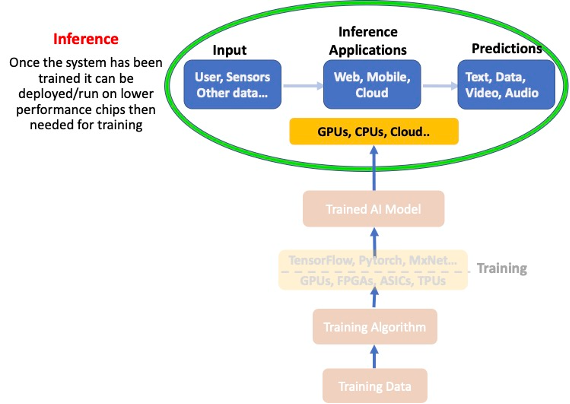
Inference can even occur locally on edge devices where physical devices meet the digital world (routers, sensors, IOT devices), close to the source of where the data is generated. This reduces network bandwidth issues and eliminates latency issues.
Machine Learning Inference - Hardware
Inference (running the model) requires substantially less compute power than training. But inference also benefits from specialized AI chips.
Machine Learning – Performance Monitoring and Retraining
Just like classic computers where software developers do regular software updates to fix bugs and increase performance and add features, machine learning models also need to be updated regularly by adding new data to the old training pipelines and running them again. Why?
Over time machine learning models get stale. Their real-world performance generally degrades over time if they are not updated regularly with new training data that matches the changing state of the world. The models need to be monitored and retrained regularly for data and/or concept drift, harmful predictions, performance drops, etc. To stay up to date, the models need to re-learn the patterns by looking at the most recent data that better reflects reality.
One Last Thing – “Verifiability/Explainability”
Understanding how an AI works is essential to fostering trust and confidence in AI production models.
Neural Networks and Deep Learning differ from other types of Machine Learning algorithms in that they have low explainability. They can generate a prediction, but it is very difficult to understand or explain how it arrived at its prediction. This “explainability problem” is often described as a problem for all of AI, but it’s primarily a problem for Neural Networks and Deep Learning. Other types of Machine Learning algorithms – for example decision trees – have very high explainability. The results of the five-year DARPA Explainable AI Program (XAI) are worth reading here.
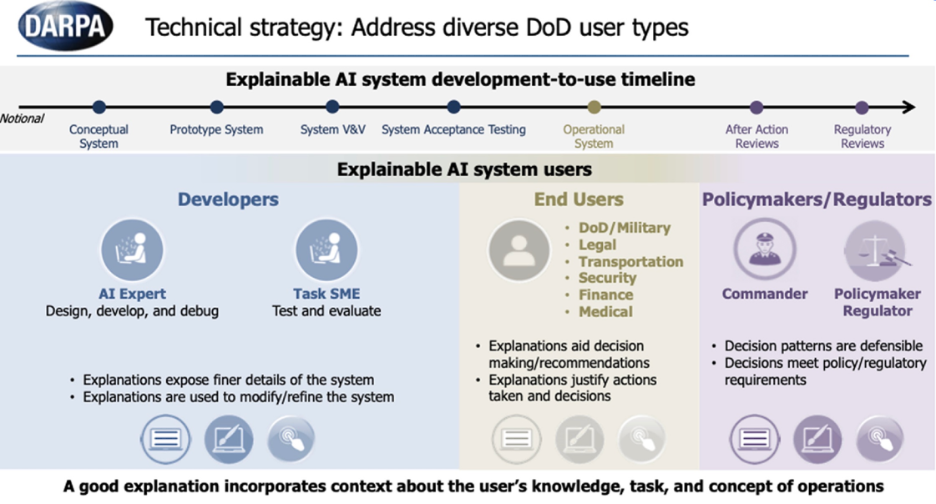
So What Can Machine Learning Do?[1]
It’s taken decades but as of today, on its simplest implementations, machine learning applications can do some tasks better and/or faster than humans. Machine Learning is most advanced and widely applied today in processing text (through Natural Language Processing) followed by understanding images and videos (through Computer Vision) and analytics and anomaly detection. For example:
Recognize and Understand Text/Natural Language Processing
AI is better than humans on basic reading comprehension benchmarks like SuperGLUE and SQuAD and their performance on complex linguistic tasks is almost there. Applications: GPT-3, M6, OPT-175B, Google Translate, Gmail Autocomplete, Chatbots, Text summarization.
Write Human-like Answers to Questions and Assist in Writing Computer Code
An AI can write original text that is indistinguishable from that created by humans. Examples GPT-3, Wu Dao 2.0 or generate computer code. Example GitHub Copilot, Wordtune
Recognize and Understand Images and video streams
An AI can see and understand what it sees. It can identify and detect an object or a feature in an image or video. It can even identify faces. It can scan news broadcasts or read and assess text that appears in videos. It has uses in threat detection - airport security, banks, and sporting events. And in retail to scan and analyze in-store imagery to intuitively determine inventory movement. Examples of ImageNet benchmarks here and here
Detect Changes in Patterns/Recognize Anomalies
An AI can recognize patterns which don’t match the behaviors expected for a particular system, out of millions of different inputs or transactions. These applications can discover evidence of an attack on financial networks, fraud detection in insurance filings or credit card purchases; identify fake reviews; even tag sensor data in industrial facilities that mean there’s a safety issue. Examples here, here and here.
Power Recommendation Engines
An AI can provide recommendations based on user behaviors used in ecommerce to provide accurate suggestions of products to users for future purchases based on their shopping history. Examples: Alexa and Siri
Recognize and Understand Your Voice
An AI can understand spoken language. Then it can comprehend what is being said and in what context. This can enable chatbots to have a conversation with people. It can record and transcribe meetings. (Some versions can even read lips to increase accuracy.) Examples: Siri/Alexa/Google Assistant. Example here
Create Artificial Images
AI can create artificial images (DeepFakes) that are indistinguishable from real ones using Generative Adversarial Networks. Useful in entertainment, virtual worlds, gaming, fashion design, etc. Synthetic faces are now indistinguishable and more trustworthy than photos of real people. Paper here.
Create Artist Quality Illustrations from A Written Description
AI can generate images from text descriptions, creating anthropomorphized versions of animals and objects, combining unrelated concepts in plausible ways. An example is Dall-E
Generative Design of Physical Products
Engineers can input design goals into AI-driven generative design software, along with parameters such as performance or spatial requirements, materials, manufacturing methods, and cost constraints. The software explores all the possible permutations of a solution, quickly generating design alternatives Example here.
Sentiment Analysis
An AI leverages deep natural language processing, text analysis, and computational linguistics to gain insight into customer opinion, understanding of consumer sentiment, and measuring the impact of marketing strategies. Examples: Brand24, MonkeyLearn
AI in National Security[2]
Much like the dual-use/dual-nature of classical computers AI developed for commercial applications can also be used for national security.
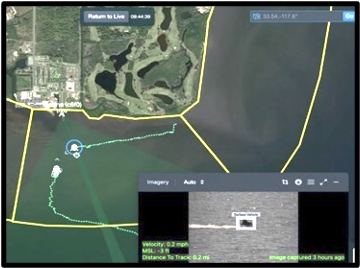
AI/ML and Ubiquitous Technical Surveillance
AI/ML have made most cities untenable for traditional tradecraft. Machine learning can integrate travel data (customs, airline, train, car rental, hotel, license plate readers…,) integrate feeds from CCTV cameras for facial recognition and gait recognition, breadcrumbs from wireless devices and then combine it with DNA sampling. The result is automated persistent surveillance.
China’s employment of AI as a tool of repression and surveillance of the Uyghurs is a dystopian of how a totalitarian regimes will use AI-enable ubiquitous surveillance to repress and monitor its own populace.
AI/ML on the Battlefield
AI will enable new levels of performance and autonomy for weapon systems. Autonomously collaborating assets (e.g., drone swarms, ground vehicles) that can coordinate attacks, ISR missions, & more.
Fusing and making sense of sensor data (detecting threats in optical /SAR imagery, classifying aircraft based on radar returns, searching for anomalies in radio frequency signatures, etc.) Machine learning is better and faster than humans in finding targets hidden in a high-clutter background. Automated target detection and fires from satellite/UAV.
For example, an Unmanned Aerial Vehicle (UAV) or Unmanned Ground Vehicles with onboard AI edge computers could use deep learning to detect and locate concealed chemical, biological and explosives threats by fusing imaging sensors and chemical/biological sensors.
Other examples include:
Use AI/ML countermeasures against adversarial, low probability of intercept/low probability of detection (LPI/LPD) radar techniques in radar and communication systems.
Given sequences of observations of unknown radar waveforms from arbitrary emitters without a priori knowledge, use machine learning to develop behavioral models to enable inference of radar intent and threat level, and to enable prediction of future behaviors.
For objects in space, use machine learning to predict and characterize a spacecraft’s possible actions, its subsequent trajectory, and what threats it can pose from along that trajectory. Predict the outcomes of finite burn, continuous thrust, and impulsive maneuvers.
AI empowers other applications such as:Flight Operations Planning Decision Aid Tool for Strike Operations Aboard Aircraft Carriers
Automated Battle management – air and missile defense, army/navy tactical…
AI/ML in Collection
The front end of intelligence collection platforms has created a firehose of data that have overwhelmed human analysts. “Smart” sensors coupled with inference engines can pre-process raw intelligence and prioritize what data to transmit and store –helpful in degraded or low-bandwidth environments.
Human-Machine Teaming in Signals Intelligence
Applications with embedded intelligence have already begun to appear in commercial applications thanks to massive language models. For example - Copilot as a pair-programmer in Microsoft Visual Studio VSCode. It’s not hard to imagine an AI that can detect and isolate anomalies and other patterns of interest in all sorts of signal data faster and more reliably than human operators.

AI-enabled natural language processing, computer vision, and audiovisual analysis can vastly reduce manual data processing. Advances in speech-to-text transcription and language analytics now enable reading comprehension, question answering, and automated summarization of large quantities of text. This not only prioritizes the work of human analysts, it’s a major force multiplier.
AI can also be used to automate data conversion such as translations and decryptions, accelerating the ability to derive actionable insights.
Human-Machine Teaming in Tasking and Dissemination
AI-enabled systems will automate and optimize tasking and collection for platforms, sensors, and assets in near-real time in response to dynamic intelligence requirements or changes in the environment.
AI will be able to automatically generate machine-readable versions of intelligence products and disseminate them at machine speed so that computer systems across the IC and the military can ingest and use them in real time without manual intervention.
Human-Machine Teaming in Exploitation and Analytics
AI-enabled tools can augment filtering, flagging, and triage across multiple data sets. They can identify connections and correlations more efficiently and at a greater scale than human analysts, and can flag those findings and the most important content for human analysis.
AI can fuse data from multiple sources, types of intelligence, and classification levels to produce accurate predictive analysis in a way that is not currently possible. This can improve indications and warnings for military operations and active cyber defense.
AI/ML Information warfare
Nation states have used AI systems to enhance disinformation campaigns and cyberattacks. This included using “DeepFakes” (fake videos generated by a neural network that are nearly indistinguishable from reality). They are harvesting data on Americans to build profiles of our beliefs, behavior, and biological makeup for tailored attempts to manipulate or coerce individuals.
But because a large percentage of it is open-source, AI is not limited to nation states. AI-powered cyber-attacks, deepfakes and AI software paired with commercially available drones can create “poor-man’s smart weapons” for use by rogue states, terrorists and criminals.
AI/ML Cyberwarfare
AI-enabled malware can learn and adapt to a system’s defensive measures, or, conversely, AI-enabled cyber-defensive tools can proactively locate and address network anomalies and system vulnerabilities.
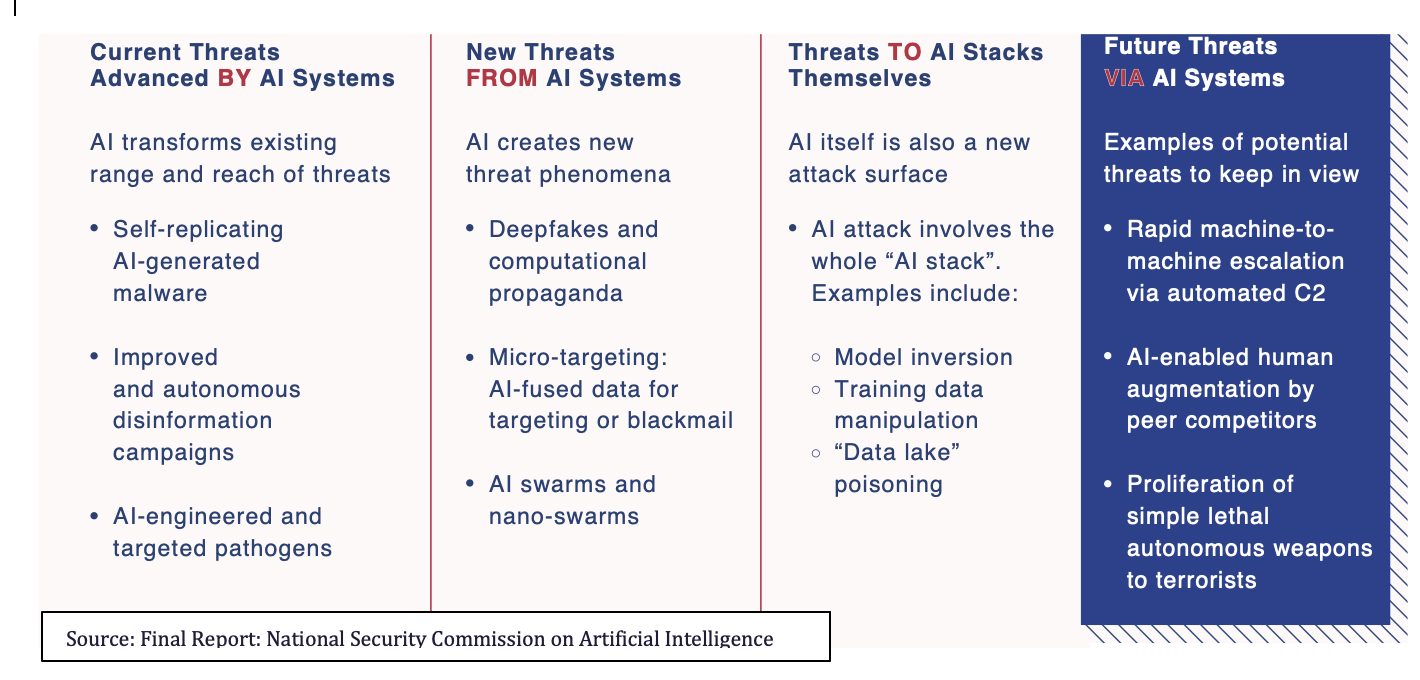
AI-driven malware, where a malicious logic embeds machine learning methods and models to automatically: (i) probe the target system for inferring actionable intelligence (e.g., system configuration or operational patterns) and (ii) customize the attack payload accordingly (e.g., determine the most opportune time to execute the payload so to maximize the impact).

Attacks Against AI - Adversarial AI
As AI proliferates, defeating adversaries will be predicated on defeating their AI and vice versa. As Neural Networks take over sensor processing and triage tasks, a human may only be alerted if the AI deems it suspicious. Therefore, we only need to defeat the AI to evade detection, not necessarily a human.
Adversarial attacks against AI fall into three types:Data misclassification- to generate false positive or negative results
Synthetic data generation-to feed false information
Data analysis – for AI-assisted classical attack generation
AI Attack Surfaces
Electronic Attack (EA), Electronic Protection (EP), Electronic Support (ES) all have analogues in the AI algorithmic domain. In the future, we may play the same game about the “Algorithmic Spectrum,” denying our adversaries their AI capabilities while defending ours. Other can steal or poison our models or manipulate our training data.
What Makes AI Possible Now?[3]
Four changes make Machine Learning possible now:Massive Data Sets
Improved Machine Learning algorithms
Open-Source Code, Pretrained Models and Frameworks
More computing power
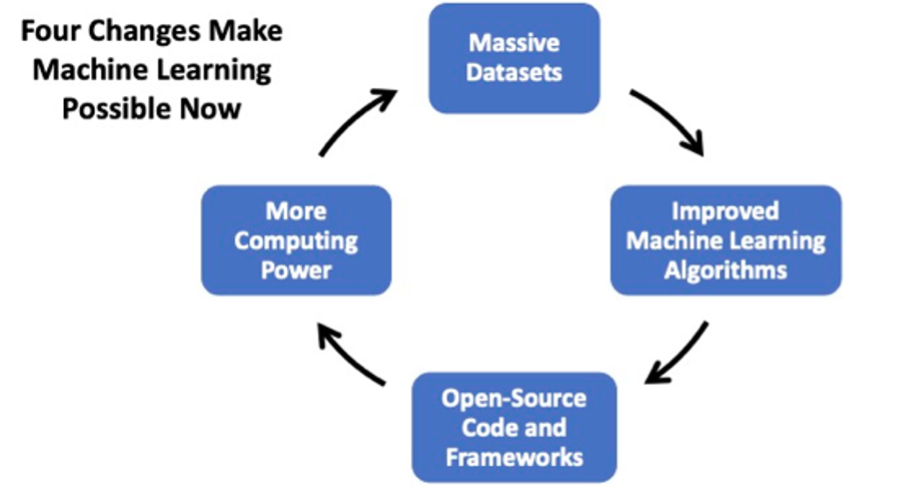
Massive Data Sets
Machine Learning algorithms tend to require large quantities of training data in order to produce high-performance AI models. (Training Google’s GPT-3 Natural Language Model with 175 billion parameters takes 1,024 Nvidia A100 GPUs more than one month.) Today, strategic and tactical sensors pour in a firehose of images, signals and other data. Billions of computers, digital devices and sensors connected to the Internet, producing and storing large volumes of data, which provide other sources of intelligence. For example facial recognition requires millions of labeled images of faces for training data.
Of course more data only helps if the data is relevant to your desired application. Training data needs to match the real-world operational data very, very closely to train a high-performing AI model.
Improved Machine Learning algorithms
The first Machine Learning algorithms are decades old, and some remain incredibly useful. However, researchers have discovered new algorithms that have greatly sped up the fields cutting-edge. These new algorithms have made Machine Learning models more flexible, more robust, and more capable of solving different types of problems.
Open-Source Code, Pretrained Models and Frameworks
Developing Machine Learning systems required a lot of expertise and custom software development that made it out of reach for most organizations. Now open-source code libraries and developer tools allow organizations to use and build upon the work of external communities. No team or organization has to start from scratch, and many parts that used to require highly specialized expertise have been automated. Even non-experts and beginners can create useful AI tools. In some cases, open-source ML models can be entirely reused and purchased. Combined with standard competitions, open source, pretrained models and frameworks have moved the field forward faster than any federal lab or contractor. It’s been a feeding frenzy with the best and brightest researchers trying to one-up each other to prove which ideas are best.
The downside is that, unlike past DoD technology development - where the DoD leads it, can control it, and has the most advanced technology (like stealth and electronic warfare), in most cases the DoD will not have the most advanced algorithms or models. The analogy for AI is closer to microelectronics than it is EW. The path forward for the DoD should be supporting open research, but optimizing on data set collection, harvesting research results, and fast application.
More computing power – special chips
Machine Learning systems require a lot of computing power. Today, it’s possible to run Machine Learning algorithms on massive datasets using commodity Graphics Processing Units (GPUs). (See the machine learning hardware section below). While many of the AI performance improvements have been due to human cleverness on better models and algorithms, most of the performance gains have been the massive increase in compute performance. (See the semiconductor section.)
More computing power – AI In the Cloud
The rapid growth in the size of machine learning models has been achieved by the move to large data center clusters. The size of machine learning models are limited by time to train them. For example, in training images, the size of the model scales with the number of pixels in an image. ImageNet Model sizes are 224x224 pixels. But HD (1920x1080) images require 40x more computation/memory. Large Natural Language Processing models -- e.g., summarizing articles, English-to-Chinese translation like Google’s GPT-3 -- require enormous models. GPT-3 uses 175 billion parameters and was trained on a cluster with 1,024 Nvidia A100 GPUs that cost ~$25 million! (Which is why large clusters exist in the cloud, or the largest companies/ government agencies.) Facebooks Deep Learning and Recommendation Model (DLRM) was trained on 1TB data and has 24 billion parameters. Some cloud vendors train on >10TB data sets.
Instead of investing in massive amounts of computers needed for training, companies can use the enormous on-demand, off-premises hardware in the cloud (e.g., Amazon AWS, Microsoft Azure) for both training machine learning models and deploying inferences.
We’re Just Getting Started
The next 10 years will see a massive improvement on AI inference and training capabilities. This will require regular refreshes of the hardware – on the chip and cloud clusters - to take advantage. This is the AI version of Moore’s Law on steroids – applications that are completely infeasible today will be easy in 5 years.
What Can’t AI Do?
While AI can do a lot of things better than humans when focused on a narrow objective, there are many things it still can’t do. AI works well in specific domain where you have lots of data, time/resources to train, domain expertise to set the right goals/rewards during training, but that is not always the case.
For example AI models are only as good as the fidelity and quality of the training data. Having bad labels can wreak havoc on your training results. Protecting the integrity of the training data is critical.
In addition, AI is easily fooled by out-of-domain data (things it hasn’t seen before). This can happen by “overfitting” - when a model trains for too long on sample data or when the model is too complex, it can start to learn the “noise,” or irrelevant information, within the dataset.[4] When the model memorizes the noise and fits too closely to the training set, the model becomes “overfitted,” and it is unable to generalize well to new data. If a model cannot generalize well to new data, then it will not be able to perform the classification or prediction tasks it was intended for. However, if you pause too early or exclude too many important features, you may encounter the opposite problem, and instead, you may “underfit” your model. Underfitting occurs when the model has not trained for enough time, or the input variables are not significant enough to determine a meaningful relationship between the input and output variables.
AI is also poor at estimating uncertainty /confidence (and explaining its decision-making). It can’t choose its own goals. (Executives need to define the decision that the AI will execute. Without well-defined decisions to be made, data scientists will waste time, energy and money.) Except for simple cases an AI can’t (yet) figure out cause and effect or why something happened. It can’t think creatively or apply common sense.
AI is not very good at creating a strategy (unless it can pull from previous examples and mimic them, but then fails with the unexpected.) And it lacks generalized intelligence e.g. that can generalize knowledge and translate learning across domains.
All of these are research topics actively being worked on. Solving these will take a combination of high-performance computing, advanced AI/ML semiconductors, creative machine learning implementations and decision science. Some may be solved in the next decade, at least to a level where a human can’t tell the difference.
Where is AI and National Security Going Next?
In the near future AI may be able to predict the future actions an adversary could take and the actions a friendly force could take to counter these. The 20th century model loop of Observe–Orient–Decide and Act (OODA) is retrospective; an observation cannot be made until after the event has occurred. An AI-enabled decision-making cycle might be ‘sense–predict–agree–act’: AI senses the environment; predicts what the adversary might do and offers what a future friendly force response should be; the human part of the human–machine team agrees with this assessment; and AI acts by sending machine-to-machine instructions to the small, agile and many autonomous warfighting assets deployed en masse across the battlefield.
An example of this is DARPA’s ACE (Air Combat Evolution) program that is developing a warfighting concept for combined arms using a manned and unmanned systems. Humans will fight in close collaboration with autonomous weapon systems in complex environments with tactics informed by artificial intelligence.
A Once-in-a-Generation Event
Imagine it’s the 1980’s and you’re in charge of an intelligence agency. SIGINT and COMINT were analog and RF. You had worldwide collection systems with bespoke systems in space, air, underwater, etc. And you wake up to a world that shifts from copper to fiber. Most of your people, and equipment and equipment are going to be obsolete, and you need to learn how to capture those new bits. Almost every business processes needed to change, new organizations needed to be created, new skills were needed, and old ones were obsoleted. That’s what AI/ML is going to do to you and your agency.
The primary obstacle to innovation in national security is not technology, it is culture. The DoD and IC must overcome a host of institutional, bureaucratic, and policy challenges to adopting and integrating these new technologies. Many parts of our culture are resistant to change, reliant on traditional tradecraft and means of collection, and averse to risk-taking, (particularly acquiring and adopting new technologies and integrating outside information sources.)
No comments:
Post a Comment